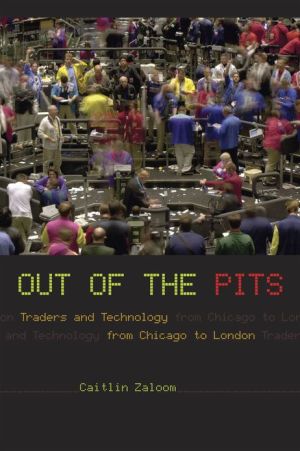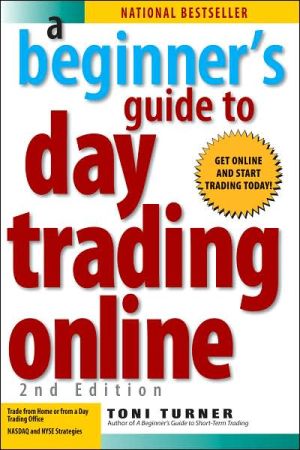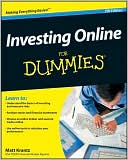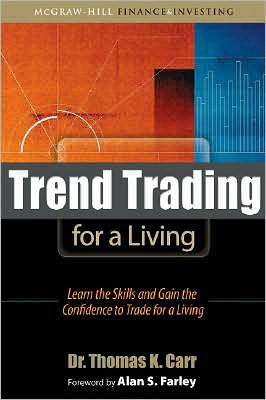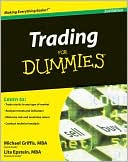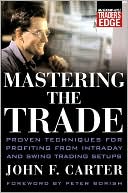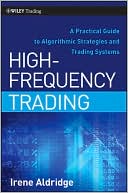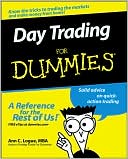Out of the Pits: Traders and Technology from Chicago to London
From New York to Singapore, from Chicago to London, the trading floors of the world’s financial markets are icons of global capitalism. Images of them are used on the news all the time—traders burying their heads in their hands when the market is down, their arms flailing in a frenzy when fortunes are rising—to convey the current state of the economy. But these marketplaces, and the cultural life that sustains them, are dissolving into the ether of the digital age: powerful financial...
Search in google:
In Out of the Pits, Caitlin Zaloom shows how traders, brokers, and global financial markets have adapted to the digital age. Drawing on her firsthand experiences as a clerk and a trader, as well as on her unusual access to key sites of global finance, she explains how changes at the world’s leading financial exchanges have transformed economic cultures and the craft of speculation; how people and places are responding to the digital transition; how traders are remaking themselves to compete in the contemporary marketplace; and how brokers, business managers, and software designers are collaborating to build new markets. A penetrating and richly detailed account of how cities, culture, and technology shape everyday life in the global economy, Out of the Pits will be required reading for anyone who has ever wondered how financial markets work. “Zaloom’s superb book is a double-site ethnography [that shows how] the appearance of chaos hid a complex social order, which Zaloom delineates beautifully.”—The London Review of Books American Journal of Sociology "A fascinating story, likely to be engaging not only for sociologists, particularly those interested in markets, but for other social scientists and nonacademic audiences as well."-American Journal of Sociology
Out of the Pits\ Traders and Technology from Chicago to London \ \ By Caitlin Zaloom \ The University of Chicago Press\ Copyright © 2006 The University of Chicago\ All right reserved.\ \ \ \ Chapter One\ LIFFE Goes Online \ In 2000, the London International Financial Futures and Options Exchange (LIFFE) evacuated their trading floors under the competitive pressures of the German-Swiss exchange and online technologies. The locals dispersed to the trading rooms and unemployment offices of London. All that is left of the LIFFE floor traders is the bronze cast of a man on the corner of Walbrook and Cannon Streets. The figure poses, legs widely planted, one arm flung out and head angled toward an outsized cell phone. His loose trading jacket is permanently spread in the wind that streams through the glass and stone funnel of the City's streets. The statue was erected in 1997 to mark the fifteenth anniversary of the London financial futures markets. Just three years later the pits were gone. The metal statue gives material form to the transition from open-outcry to electronic trading in the City of London. By the millennium, the LIFFE floor trader had become the most recent casualty of the ascendance of electronic markets in financial futures.\ The LIFFE floor traders are memorialized by this bronze statue that stands on a corner near the defunct trading floor. Photo by author. At the same time that the LIFFE trading pits were closing, dealing rooms at large banks were replacing the barrow boys withmore educated employees. The original barrow boys were associated with currency and futures dealing, markets that used fairly simple trading techniques. As financial instruments got increasingly more complicated, with swaps and options becoming more widespread, banks recruited university graduates to deal in these complex markets. The ascendance of the educated group reasserted the class character of the City that the barrow boys had challenged. Many of these original currency dealers and futures traders found themselves without jobs as the LIFFE floor closed and dealing rooms in the City were reconfigured. These cast-off traders were very pleased to find work at Perkins Silver as their opportunities at other City venues closed.\ A Perkins Silver trader who had been a LIFFE stalwart explained to me that many of his buddies from the trading floor had tried and failed to make the transition to online trading. Freddie recounted the career trajectories of his friends who had left the LIFFE. Some had gone belly up and some were driving minicabs. "It is very hard to go from making ten thousand pounds a month to that," he lamented. He assigned dire percentages to the possibilities of success-40 percent of them had tried to move to screen trading, and about 85 percent of those had now quit. Freddie himself was struggling with the transition. I later learned from him that he had had recently had his best month yet on the screen. He had made a scant eight hundred pounds in profits. Joshua Geller, whose experience as a trader, trainer, and manager lent more credibility to his estimates, painted a similarly bleak picture of the transition from pit to screen; 5 to 10 percent would succeed, he offered. Yet at the same time that Perkins Silver was hiring the barrow boys to try their luck in online futures, the managers were also participating in the professionalization of the City that was displacing these same actors.\ American Trading in European Markets\ As LIFFE went digital and the old markets closed, Perkins Silver sought to step into the void and supply some of the liquidity that the London locals had supported in the rough and tumble pits. Not only the LIFFE but also Eurex [the joint German-Swiss futures and options exchange] and MATIF [the French futures exchange, now merged into Euronext] needed online market-makers to ensure that customers would find consistent markets on their exchange. Focusing on Eurex, the largest and potentially most lucrative of the three markets, Perkins Silver planned to capture 5 to 10 percent of the business on that exchange. More than that and "we would be trading with ourselves," Adam Berger, the lead Perkins Silver manager and strategist, told me. With the expertise of Chicago locals, Perkins Silver was positioned to skim profits from the transactions that flowed through these exchanges.\ As Perkins Silver was opening its office next door to the LIFFE, the pits that writhed below its windows were slowly dying, and the Chicago model of speculation was disappearing from the trading floor. But it was reappearing online as the Perkins Silver dealing room adapted to the new context of electronic markets for European financial futures. Yet the pit-trading techniques by which Chicago traders and Perkins Silver founders flourished were not easily transposed to the London marketplace or to the new regime of online trading. The face-to-face auctions, where the Perkins Silver founders had developed their talents, thrived on the controlled chaos in the pits. In contrast, electronic futures markets link traders in a neatly networked web of dealing rooms, in which market transactions are played out not in shouts and frenetic hand gestures but through the boldface type of constantly changing numbers on a graphic user interface. Yet neither the Perkins Silver executives nor the futures and foreign exchange traders who staffed their dealing room had much experience with online trading. At the same time, this radical break from open-outcry trading technology provided an opportunity for Perkins Silver's managers to advance their ideas for improving the composition of the dealing room by recruiting new kinds of traders. In this new technological and social environment, what resources could Perkins Silver draw on to pursue its ambitions in the new markets?\ The challenge facing the managers and trainers of Perkins Silver was to translate Chicago-style speculation not only for the London lads who would staff their dealing room, but also for the emerging technologies of online trading. The Perkins Silver executives were not content simply to reproduce the population of the Chicago pit, which they perceived as composed of destructive cliques. In their view, the insular networks corrupted the purity of the market and excluded potentially profitable traders who lacked the personal contacts or did not fit the ethnic or gender profile that allowed access to trading jobs. Perkins Silver wanted to build a trading team that would be most effective in the market and that would correct imperfections in the Chicago markets. They would substitute abstract principals for personal recruiting networks. Their recruitment and training strategies were based on professionalization, American-style multiculturalism, and meritocracy. The Perkins Silver managers planned to engineer the social content and context of their dealing room to create an efficient trading machine.\ Recruiting Futures Traders\ The new traders were the raw materials from which the managers constructed a Chicago-style trading room in London, planning the social content of the trading room to draw profits to the firm. Particularly, the Perkins Silver managers sought to take advantage of the underutilized trading talent of new university graduates, minorities, and women. They believed that individuals from these groups would bring new perspectives to reading the market, allowing Perkins Silver to profit from their elimination of barriers to participation based on race and gender. The Perkins Silver strategy was based on the idea that education, experience, and membership in different racial, ethnic, and gender categories and levels of education shaped the each individual's vision.\ The Perkins Silver trainers set out to recruit traders. Adam Berger and Joshua Geller, the two leading Perkins Silver managers, had clear ideas about who would make a good futures trader. The most obvious were those who already had some proven record in the industry. In London, these were mostly currency traders recruited from investment banks and futures traders from the floor of the LIFFE. With their dealing skills in place, these traders would have to reorient themselves from the telephones of foreign exchange dealing and the face-to-face world of the pits to a new focus on the screen. Perkins Silver recruited many barrow-boy traders who had been laid off as the City labor market sought university graduates.\ Adam and Joshua interviewed some who applied in response to newspaper ads or word of mouth. The managers sought people with certain "personality characteristics" that they used as proxies for undeveloped trading skill, even while acknowledging that, as one of the codirectors of the firm told me, "no profile assures that someone will be a good trader." Joshua had a list of traits they required, drawn from the executives' collective experience and knowledge of traders on the CBOT trading floor. They looked for recruits who worked with aplomb under pressure, were "dogged," ambitious, and had decent math skills. The managers preferred their recruits to be single. They observed that trading was a more difficult and stressful task when a family's budget was on the line. A speculator should not be worried about such "extraneous" matters as whether he will be able to pay for his wife's car or the family vacation.\ The Perkins Silver managers were also looking for risk-takers. Joshua told me, "Give me a room full of outsiders. Immigrants. People who came to the city with no friends. People who are hungry." Some of the traders he had recruited for the Chicago dealing room served as models for his London endeavors. Two prime examples were a woman who had worked on attack helicopters in the Persian Gulf and a young man who had grown up in one of Chicago's most notorious housing projects and was determined to escape his poor neighborhood. Joshua saw material desires as evidence of ambition and drive. One of the directors of the firm was impressed with a woman who told him she wanted to be a trader because she had expensive taste. For their newest cohort of traders-the one that I was to join as an anthropologist and neophyte futures dealer-they were bringing in "graduate trainees," a group of young men and women between the ages of twenty-one and twenty-five with university degrees. The Perkins Silver innovation was to build a group of traders that would have diverse ways of reading the market.\ In mid-September of 2000, the new group that Joshua and Adam had assembled was gathered in the conference room in the Perkins Silver office. From appearances, it was a truly motley crew. Sitting next to me at the back of the table was Paul. He slouched in his chair with his knees wide apart and arms crossed, showing off his thick rings, one with a polished black stone set against his pale skin. His cagey style masked his rigorous training in math and science at Imperial College. Next to us, two neatly dressed white women were flanked by a thirty-something man with an early Beatles-era haircut and a tall, round-faced black man with short dreadlocks and a Midlands accent. Two small Asian (Indian) men, a sleepy, male Orthodox Jew, and I, "the American girl," completed this group. The thirty-something man, was our group's sole representative of the barrow-boy traders who dominated the trading room we were all about to enter. Trevor had worked for eleven years as a foreign exchange trader, been laid off, and spent a year traveling in Asia to tourist spots already filled with British vacationers. He broke the silence in the room by spitting out a question in a thick Cockney accent: "OK, so who are the drinkers here?" He assumed he would get a ready, affirmative response. But instead of pointing to themselves and making a date to go to the pub after work, many of the new traders looked furtively around the room. "Drinker" was apparently not the image they wanted to declare to their new employers and colleagues in their first day on the job. Matt broke the uncomfortable silence with a soft chuckle and a light statement of self-incrimination. Sarah chimed in, "I've been known to have a few." The rest of us fidgeted while we waited for the managers to appear and take control.\ After about twenty minutes of early morning quiet, Joshua Geller and Andrew Blair, the London risk manager and trainer, entered the room. They complemented each other. Joshua's energy spilled out of his wide smile. His fringe of hair circled his head electrically. Andrew, himself a currency trader in London markets for sixteen years, meandered through his introductory speech, finishing his statement by articulating, with a schoolmistress's stridency, a zero-tolerance policy for drinking during work hours. Alcohol, the managers believed, gave traders a sense of false confidence, and the traders' weakened judgment could cost them profits.\ After the initial introductions, the training started. Many of the recruits had never been in a dealing room before and had little experience with finance. But the Perkins Silver trainers understood that deep knowledge of the financial products was not necessary to trade successfully. According to the Perkins Silver executive, and many other traders I interviewed, a good trader could deal in any product. The particulars of the contract itself were not important; a good trader has mastery over the techniques of speculation. So the Perkins Silver trainers focused on producing speculators, not experts in government debt products. Their techniques emphasized creating new relationships to the self and instructed the new group in the particular skills that futures dealers use. They did not on insist on technical mastery of the internal workings of financial instruments or their theoretical bases.\ The lessons started out simply, with questions like What is a bond? What is a futures contract? But the curriculum quickly moved beyond that to explain the two techniques that most of us would use to trade in our own accounts: scalping and spreading. Both techniques focus on the profits to be made in the daily fluctuation of futures markets. Scalping focuses on the price movements in a single contract. The scalper buys contracts that he expects to rise in price, or at least he anticipates being able to make money by buying at the bid and selling at the asking price. Spreading takes advantage of the difference in volatility between bonds of different durations. The Perkins Silver managers directed most of their traders work with spread in ten-, five- and two-year German Treasury bond futures nicknamed the Bund, Bobl, and Shaz. The price of a ten-year bond is more volatile than that of a two-year bond because the longer time frame presents more opportunities for changing economic conditions and involves greater uncertainties. A spreader takes opposite positions in each of two instruments, using the more stable contract to limit the loss potential of a position in the more volatile product. These techniques take no more than a day or two to master conceptually. For traders whose computation skills were slow, "cheat sheets" were available that did the work of calculating the initial position of the spread.\ Joshua advised that we pursue other training techniques on our own time. Particularly, he suggested playing video games. Minefield was a favorite of Joshua's. We spent the mornings in class and the afternoons in developing our skills on a program that simulated an arbitrage market. Glued to our screens, we simulated buying and selling cotton futures in New York and London. Later we graduated to trading with real data from past LIFFE markets. Each program tallied up our wins and losses in discreet rounds, as in a video game. These mock markets allowed us to develop online trading skills before "going live," armed with Perkins Silver cash. These programs taught the group some fundamental lessons about the gamelike character of trading and the intense focus necessary, as well as sharpening our hand-eye coordination.\ The physical demands of online trading centered on the ability to recognize visually a profit opportunity and implement a decision to buy or sell by clicking a mouse. One crucial problem we had to surmount during this period was known as "fat fingering"-clicking the right button on the mouse rather than the left. While this has little consequence in a word processing or spreadsheet program, in a live market it is critical. The left button allows the trader to join the bid or offer. The right button, the danger button, sells directly into the bid or buys the offer, establishing a position opposite to the one the trader intended. Establishing control over these opposite intentions embodied in a quick, sharp twitch of barely separated fingers at first took much concentration. Even the more experienced traders sometimes suffered from lapses in manual control. "Ahh, I've fat-fingered it," an unlucky trader would cry with disgust, desperately trying to get out of his position before the losses mounted.\ (Continues...)\ \ \ \ \ Excerpted from Out of the Pits by Caitlin Zaloom Copyright © 2006 by The University of Chicago . Excerpted by permission.\ All rights reserved. No part of this excerpt may be reproduced or reprinted without permission in writing from the publisher.\ Excerpts are provided by Dial-A-Book Inc. solely for the personal use of visitors to this web site. \ \
Preface AcknowledgmentsIntroduction: Finance from the Floor Chapter 1 Materials of the Market Chapter 2 Trapped in the Pits Chapter 3 Social Experiments in London Markets Chapter 4 The Work of Risk Chapter 5 Economic Men Chapter 6 The Discipline of the Speculator Chapter 7 Ambiguous Numbers Conclusion: Practical Experiments Notes Bibliography Index
\ Business��History Review"In her brilliant qualitative study . . . Zaloom makes a strong case for the relevance of cultural analysis in extending our understanding of the functionality and evolution of organized markets and exchanges. Her excellent achievement demonstrates the power of interdisciplinary approaches in extending the scope and the richness of scholarship in business and economic history."—Business History Review\ \ \ \ \ \ London Review of Books - Donald MacKenzie\ "Zaloom's superb book is a double-site ethnography. She first worked as a runner on the Chicago Board of Trade. . . . The appearance of chaos hid a complex social order, which Zaloom delineates beautifully."\ \ \ \ London Review of BooksZaloom's superb book is a double-site ethnography. She first worked as a runner on the Chicago Board of Trade. . . . The appearance of chaos hid a complex social order, which Zaloom delineates beautifully.\ — Donald MacKenzie\ \ \ \ \ \ American Journal of Sociology"A fascinating story, likely to be engaging not only for sociologists, particularly those interested in markets, but for other social scientists and nonacademic audiences as well."\ \ \ \ \ \ Theory and Society"Zaloom's account of the social world of the pits . . . demonstrates interpretive skills reminiscent of classics of cultural and economic anthropology. In this book, she has provided an empirically rich and theroretically sophisticated ethnographic account."—Theory and Society\ \ \ \ \ \ Business History ReviewIn her brilliant qualitative study . . . Zaloom makes a strong case for the relevance of cultural analysis in extending our understanding of the functionality and evolution of organized markets and exchanges. Her excellent achievement demonstrates the power of interdisciplinary approaches in extending the scope and the richness of scholarship in business and economic history.—Business History Review\ \
